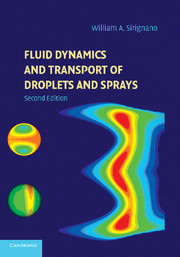Book contents
- Frontmatter
- Contents
- Preface
- Nomenclature
- 1 Introduction
- 2 Isolated Spherically Symmetric Droplet Vaporization and Heating
- 3 Convective Droplet Vaporization, Heating, and Acceleration
- 4 Multicomponent-Liquid Droplets
- 5 Droplet Behavior under Near-Critical, Transcritical, and Supercritical Conditions
- 6 Droplet Arrays and Groups
- 7 Spray Equations
- 8 Computational Issues
- 9 Spray Applications
- 10 Spray Interactions with Turbulence and Vortical Structures
- 11 Film Vaporization
- 12 Stability of Liquid Streams
- Appendix A The Field Equations
- Appendix B Conserved Scalars
- Appendix C Droplet-Model Summary
- Bibliography
- Index
4 - Multicomponent-Liquid Droplets
Published online by Cambridge University Press: 05 June 2012
- Frontmatter
- Contents
- Preface
- Nomenclature
- 1 Introduction
- 2 Isolated Spherically Symmetric Droplet Vaporization and Heating
- 3 Convective Droplet Vaporization, Heating, and Acceleration
- 4 Multicomponent-Liquid Droplets
- 5 Droplet Behavior under Near-Critical, Transcritical, and Supercritical Conditions
- 6 Droplet Arrays and Groups
- 7 Spray Equations
- 8 Computational Issues
- 9 Spray Applications
- 10 Spray Interactions with Turbulence and Vortical Structures
- 11 Film Vaporization
- 12 Stability of Liquid Streams
- Appendix A The Field Equations
- Appendix B Conserved Scalars
- Appendix C Droplet-Model Summary
- Bibliography
- Index
Summary
There are various complications that occur when a multicomponent liquid is considered (Landis and Mills, 1974, and Sirignano and Law, 1978). Different components vaporize at different rates, creating concentration gradients in the liquid phase and causing liquid-phase mass diffusion. The theory requires the coupled solutions of liquid-phase species-continuity equations, multicomponent phase-equilibrium relations (typically Raoult's Law), and gas-phase multicomponent energy and species-continuity equations. Liquid-phase mass diffusion is commonly much slower than liquid-phase heat diffusion so that thin diffusion layers can occur near the surface, especially at high ambient temperatures at which the surface-regression rate is large. The more volatile substances tend to vaporize faster at first until their surface-concentration values are diminished and further vaporization of those quantities becomes liquid-phase mass diffusion controlled.
Mass diffusion in the liquid phase is very slow compared with heat diffusion in the liquid and extremely slow compared with momentum, heat, or mass diffusion in the gas film or compared with momentum diffusion in the liquid. In fact, the characteristic time for the liquid-phase mass diffusion based on droplet radius is typically longer than the droplet lifetime. Nevertheless, this mass diffusion is of primary importance in the vaporization process for a multicomponent fuel. At first, early in the droplet lifetime, the more volatile substances in the fuel at the droplet surface will vaporize, leaving only the less volatile material that vaporizes more slowly. More volatile material still exists in the droplet interior and will tend to diffuse toward the surface because of concentration gradients created by the prior vaporization.
- Type
- Chapter
- Information
- Fluid Dynamics and Transport of Droplets and Sprays , pp. 90 - 133Publisher: Cambridge University PressPrint publication year: 2010



